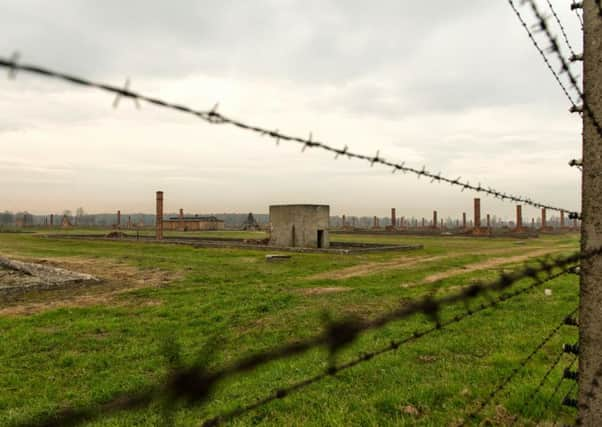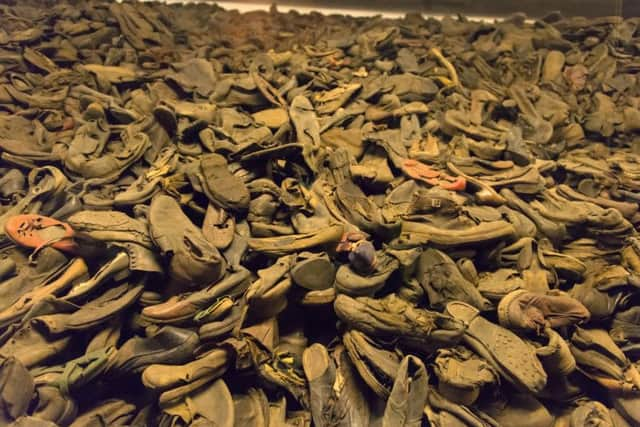We must remember them to stop this happening again


There are many numbers which can be used to describe the concentration camps at Auschwitz.
Around 1.2 million lives lost – more than three times the population of West Sussex.
Advertisement
Hide AdAdvertisement
Hide AdFour gas chambers at Auschwitz-Birkenau – capable of killing up to 1,200 people in just 20 minutes.


Three camps – Auschwitz I holding around 15,000 prisoners, Auschwitz-Birkenau, with more than 90,000 prisoners in 1944, and Auschwitz Monowitz, the labour camp.
One red-and-cream leather high-heeled shoe.
In a room full of shoes belonging to those murdered at Auschwitz-Birkenau this simple thing stood out.
It made me wonder – did the woman it belonged to wear it because she had no idea what waited for her or was it an act of defiance, a statement of her identity, a refusal to become an anonymous prisoner?
Advertisement
Hide AdAdvertisement
Hide AdThis is why the Holocaust Educational Trust takes hundreds of students to the camps every year – to remind them and us all that Auschwitz is more than numbers. Each of those 1.2 million was a person with a family and a story of their own.
The camp where they lost their lives stands as a reminder that we should never let hate take over our humanity.
When I visit with sixth-form students from across the south,, our day begins not in the camps but in the town of Oswiecim (Auschwitz is its Germanised name).
In 1939, 58 per cent of the town’s population was Jewish – around 7,000 people.
Now, there are no Jews living in Oswiecim.
Advertisement
Hide AdAdvertisement
Hide Ad“We are looking at a thriving community of people, of families that are no longer here,” said trust educator Louise Cramp.
The final member of the pre-war community to live in the town was Szymon Kluger. Having survived the Holocaust, he returned to his home town, living as a hermit until his death in 2000.
He is buried in the Jewish cemetery but the graves here are a stark contrast to the well-maintained plots we drove past on our way from Krakow.
The headstones had to be restored after being used as paving slabs by the Nazis.
Advertisement
Hide AdAdvertisement
Hide AdNo-one knows if they are placed correctly and there is no-one left to tend them.
“It shows the level of disrespect they had for the Jewish people,” said Worthing College sixth-form student Olivia Carter.
A short drive later, we are walking under the gate with those infamous words ‘arbeit macht frei’ ‘work sets you free’ — a false hope for the thousands who lost their lives.
This is the entrance to Auschwitz I which was functioning by the end of 1940.
Advertisement
Hide AdAdvertisement
Hide AdOriginally, those destined for Auschwitz were political prisoners, prisoners of war, Roma and Sinti, and Jews.
As well as being tattooed, they were also photographed.
However, as the number of prisoners grew, only certain groups had their pictures taken and those who were destined to die on arrival were not registered at all.
Now, the orderly rows of brick barracks which once acted as prisons house exhibits giving visitors an insight into the lives and deaths of Holocaust victims.
It is here you begin to get a sense of the scale of the killing and the brutal efficiency of the camps — particularly once the much larger Auschwitz-Birkenau site was built.
Advertisement
Hide AdAdvertisement
Hide AdWe enter a room where behind a large glass wall piles of women’s hair sits. You can still make out some of the braids and plaits from old and young – the first but not last moment of my visit when I break out in goosebumps.
The hair was shaved off women killed in the gas chamber to make material for blankets and soldiers’ uniforms.
Another room holds the clothes of babies and children, another suitcases with the names and dates of birth of those who carried them, yet another cooking utensils in reds, blues and whites – a sign of kosher food preparation.
We walk through a corridor lined with the faces of those murdered, see photographs taken once the camps were liberated of emaciated babies and women used in the fertility experiments and visit the haunting punishment cells.
Advertisement
Hide AdAdvertisement
Hide AdIt is overwhelming yet could never be enough to allow one to truly understand the horror of life here.
“Now that I have seen it first-hand, it is completely different,” said Lauren Guest, from Chichester High School for Girls.
“I don’t think you can understand the devastation it caused until you come yourself.
“But not everyone is in the situation where they are able to come here themselves.
Advertisement
Hide AdAdvertisement
Hide Ad“That is why it is important to spread the message when we get back.
“It is important to remember, there are not a lot of survivors now so we need to spread the message.”
Auschwitz-Birkenau offers yet another perspective.
Here, the earlier brick buildings gave way to the rows and rows of wooden huts so often imagined when we talk about the Holocaust.
Most of those are gone now. Seemingly endless lines of chimneys mark where they stood. The railway line leading to the large gas chambers remains, however.
Advertisement
Hide AdAdvertisement
Hide AdWe stand on the spot where the 20 per cent selected for work were granted a temporary reprieve.
For the rest – women with infants, Jewish children too young to work, the elderly and infirm, it was straight from the tracks to the gas chambers.
It is near the collapsed gas chambers that Rabbi Barry Marcus led a short service of remembrance. For the students, it was a moving experience.
“When I was walking around it didn’t really sink in,” said Beth Green, from the Littlehampton Academy. “I knew what I was seeing but it still didn’t seem as real as I thought it would. After the service it has hit me that it is real and what I was seeing is real.”
Advertisement
Hide AdAdvertisement
Hide AdFor these students, who will now act as Holocaust ambassadors for the trust, the purpose of the visit is clear.
“The more you can tell people about it, the less likely it is that it will happen again,” said Bethany Lee, from Chichester High School for Girls.